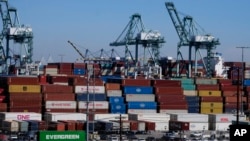The U.S. trade deficit in goods widened sharply in September, likely as a strong dollar and softening global demand weighed on exports, but that did not change expectations that trade led an anticipated rebound in economic growth in the third quarter.
The report from the Commerce Department on Wednesday also showed moderate increases in wholesale and retail inventories last month, suggesting slowing domestic demand was forcing businesses to become more cautious about ordering more goods.
The Federal Reserve is aggressively hiking interest rates to tame inflation, boosting the dollar and curbing spending.
"Trade will likely be a significant tailwind for growth in the near term," said Abbey Omodunbi, a senior economist at PNC Financial in Pittsburgh, Pennsylvania.
The goods trade deficit increased 5.7% to $92.2 billion last month. September's increase reversed only a portion of the prior months' declines, leaving the goods trade deficit considerably lower in the third quarter.
Exports of goods fell $2.8 billion to $177.6 billion. The decline was led by a 14.0% tumble in food exports. Shipments of industrial supplies, which include crude oil, fell 3.1%.
Exports of consumer goods also declined. But there were increases in exports of capital goods, motor vehicles and other goods. The dollar has gained nearly 11% against the currencies of the United States' main trade partners this year.
Goods imports rose 0.8% to $269.8 billion. They were lifted by a 4.4% jump in imports of capital goods, which bodes well for business spending on equipment. There were also increases in imports of motor vehicles and consumer goods. But imports of food, industrial supplies and other goods fell.
"Net exports will contribute significantly to GDP growth in third quarter, adding about 3.0 percentage points," said Daniel Silver, an economist at JPMorgan in New York.
"While the trade deficit looks to have narrowed substantially in third quarter, we think that the stronger dollar will help push the deficit wider over time."
The Commerce Department also reported that wholesale inventories increased 0.8% last month after advancing 1.4% in August. Stocks at retailers gained 0.4% after rising 1.4% in August. Retailers are finding themselves saddled with excess merchandise, a function of both easing supply chain bottlenecks and slowing demand for goods, forcing them to offer discounts.
Motor vehicle inventories increased 1.9% after surging 3.5% in August. Excluding motor vehicles, retail inventories dipped 0.1% after rising 0.7% in August. This component goes into the calculation of gross domestic product.
The data was published ahead of the release on Thursday of the government's advance estimate of third-quarter GDP. According to a Reuters survey of economists, GDP likely rebounded at a 2.4% annualized rate last quarter after declining at a 0.6% pace in the April-June quarter.
The economy contracted in the first half of 2022, but is likely not in recession, with more than 2.5 million jobs created during that period.







